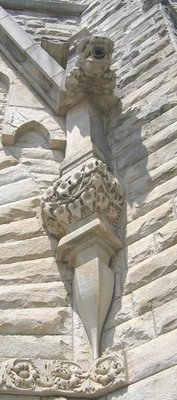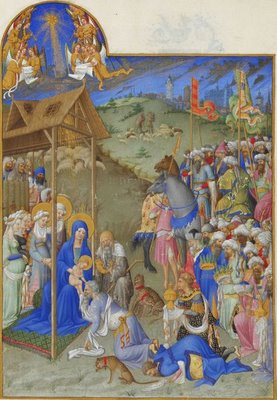 The adoration of the Magi, from the great 15th century illuminated manuscript, the Tres Riches Heures of the Duc de Berry, now at the Musee Conde, at Chantilly.
The adoration of the Magi, from the great 15th century illuminated manuscript, the Tres Riches Heures of the Duc de Berry, now at the Musee Conde, at Chantilly.A tribute to the treasure trove of ecclesiastical art and architecture in the Diocese of Toledo.
Thursday, November 30, 2006
A Bonus Post
 The adoration of the Magi, from the great 15th century illuminated manuscript, the Tres Riches Heures of the Duc de Berry, now at the Musee Conde, at Chantilly.
The adoration of the Magi, from the great 15th century illuminated manuscript, the Tres Riches Heures of the Duc de Berry, now at the Musee Conde, at Chantilly.Saints In The Neighborhood
 St. Alphonsus Parish, at Peru, in Huron County, has a great distinction. For a few months in 1841, it's pastor was none other than St. John Neumann, later Bishop of Philadelphia. For more information about the life of this great man, click HERE .
St. Alphonsus Parish, at Peru, in Huron County, has a great distinction. For a few months in 1841, it's pastor was none other than St. John Neumann, later Bishop of Philadelphia. For more information about the life of this great man, click HERE .A Busy Week
Things are rather hectic, but they should settle down enough for me to get back on a regular schedule of posts by next week.
A Request For Information
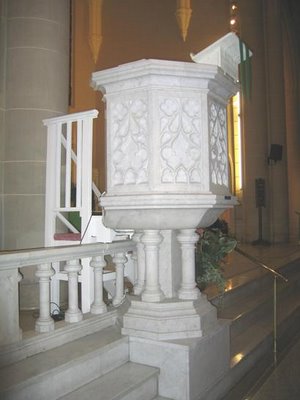 The pulpit of Immaculate Conception Church in the Old South End. The pulpit, three altars, and communion rail, of Cararra marble, were made at Pietrasanta, Italy in the late 1920's. They were designed, as part of the interior and exterior modifications to the church made after the fire of 1920, by Toledo architect Joseph C. Huber, Jr. Mr Huber also designed St. Stephen's in East Toledo. He died in Indiana in 1954. If anyone has any information on Mr. Huber and his work it would be a great help to my research. Please contact me at rovingmedievalist@yahoo.com.
The pulpit of Immaculate Conception Church in the Old South End. The pulpit, three altars, and communion rail, of Cararra marble, were made at Pietrasanta, Italy in the late 1920's. They were designed, as part of the interior and exterior modifications to the church made after the fire of 1920, by Toledo architect Joseph C. Huber, Jr. Mr Huber also designed St. Stephen's in East Toledo. He died in Indiana in 1954. If anyone has any information on Mr. Huber and his work it would be a great help to my research. Please contact me at rovingmedievalist@yahoo.com.Tuesday, November 28, 2006
Please Bear With Me
I've had some good news today that has me in too good a mood to think clearly. I'll catch up when the euphoria wears off.
Monday, November 27, 2006
Always Look Up
Darby Homecoming
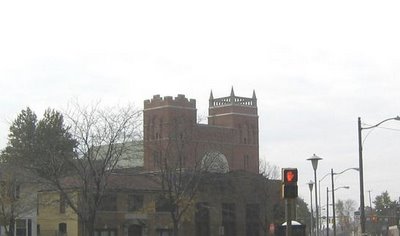 The annual Darby Homecoming Mass will be celebrated at Immaculate Conception Church in the Old South End, on Sunday, December 3 at 3:00PM. Bishop Blair will officiate. A reception will follow. For those who aren't familiar with the term, the Immaculate Conception Parish has been known as "Old Darby" and its school as "Darby College" for many years. No one is quite sure why.
The annual Darby Homecoming Mass will be celebrated at Immaculate Conception Church in the Old South End, on Sunday, December 3 at 3:00PM. Bishop Blair will officiate. A reception will follow. For those who aren't familiar with the term, the Immaculate Conception Parish has been known as "Old Darby" and its school as "Darby College" for many years. No one is quite sure why.Saturday, November 25, 2006
St. Francis de Sales
 Toledo's first cathedral, from 1910 to 1940. St Francis de Sales was completed in 1869 from plans by Patrick Keely of New York. Keely designed more than four hundred churches in his career. Though the parish is closed, St. Francis de Sales is used as a chapel for the Downtown business district, offering weekday Masses at 12:15 PM. Don't let the simple exterior fool you, the interior is incredible. I'll post more about it as time goes on.
Toledo's first cathedral, from 1910 to 1940. St Francis de Sales was completed in 1869 from plans by Patrick Keely of New York. Keely designed more than four hundred churches in his career. Though the parish is closed, St. Francis de Sales is used as a chapel for the Downtown business district, offering weekday Masses at 12:15 PM. Don't let the simple exterior fool you, the interior is incredible. I'll post more about it as time goes on.An Interesting Thought
I was reminded of an old question this morning. If you were arrested for being a Catholic,( there's been more danger of that happening in the last century than ever before ) would there be enough evidence to convict you? Think about it.
Friday, November 24, 2006
Our Lady of San Juan de los Lagos
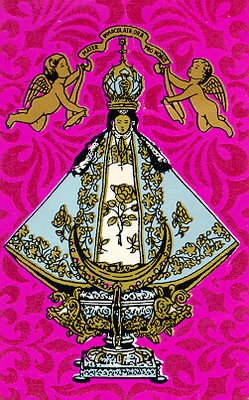 I attended the Thanksgiving Day Mass at Sts. Peter and Paul, in the Old South End. Very impressive interior. I'll post on it later but I wanted to mention one particularly interesting feature. In the vestibule is an obviously old, obviously highly-respected statue of Our Lady. It was brought from Mexico many years ago and is surrounded by small metal "milagros." A milagro is an ex voto offering given in gratitude for an answered prayer. They're often in a shape recalling the request, a figure of a leg for a healed knee problem, for example. The figure of Our Lady is a replica of one of the most venerated images of Our Lady in Mexico.
I attended the Thanksgiving Day Mass at Sts. Peter and Paul, in the Old South End. Very impressive interior. I'll post on it later but I wanted to mention one particularly interesting feature. In the vestibule is an obviously old, obviously highly-respected statue of Our Lady. It was brought from Mexico many years ago and is surrounded by small metal "milagros." A milagro is an ex voto offering given in gratitude for an answered prayer. They're often in a shape recalling the request, a figure of a leg for a healed knee problem, for example. The figure of Our Lady is a replica of one of the most venerated images of Our Lady in Mexico.Our Lady of San Juan de los Lagos was brought to a village in Jalisco by Father Juan de Bologna, in 1542. The image stands about twenty inches tall and is made in a manner common to the Tarascans of neighboring Michoacan. Corn pith and orchid juice is blended and molded over a frame of cane or wood. Then a layer of gesso is applied and the figure is painted. At some time in the late 16th or early 17th centuries, a wide flaring frame was added to dress the figure. The crown and the crescent moon at her feet date from the same time.
The image was venerated from an early date. According to the story, Our Lady's intercession saved the life of an Indian girl who was either close to death or already dead. In a very short time San Juan de los Lagos had become a popular destination for pilgrims. The present church was built in 1732, and was made a basilica by Pius XII. For more information about the veneration of Our Lady in this guise, click HERE.
Though little noticed, Toledo's image of Our Lady of San Juan de los Lagos, Our Lady of San Juan of the Lakes, is worthy of respect and reverence. Perhaps all of us should pay her a visit.
Wednesday, November 22, 2006
A Note Of Honor And Thanks
To all the people of the Diocese, past and present, who gave their time, their talents, and their hard-earned money to build, furnish, and maintain our beautiful churches. May God honor their sacrifice and reward their faithfulness.
Stay Tuned
Later in the week, I'll be posting more pictures, particularly some of St. Francis de Sales, on Cherry Street, Toledo's first cathedral, of St. Patrick's on Avondale, and of St. Joseph's in the Vistula Historic District. We'll also have a series on saints and potential saints with ties to Ohio. I'm working on a list of links to internet sites that will be useful to us, especially parish websites. ( every parish should have one. ) Feel free to e-mail pictures of your parish and any suggestions or comments. We'll also have occasional posts on churches in Toledo, Spain, and in Toledo's sister cities around the world.
Immaculate Conception
 I'm particularly proud of this one, since it happens to be my parish. What you see is the product of forty years of work by three architects. The church was built, in 1897, to a design by E. O. Fallis, the designer of the Valentine Theater and one of Toledo's most prominent architects. The roof was lowered by a full twenty feet after a disastrous fire in 1920. Joseph C. Huber was responsible for the modifications and work on the interior. Finally, in 1938, Wilfred Holtzman added the caps to the towers, with a lot of input from Monsignor Sawkins, the pastor. The rose window was added in 1928 and involved adding 35 tons of stonework to the existing wall, a good feat of engineering. The wrought iron cross on top of the blind arcade is notable, as is the flamboyant tracery of the transom windows. I'm working on a guide to the building and its interior, so you'll be hearing a lot about this parish in the future.
I'm particularly proud of this one, since it happens to be my parish. What you see is the product of forty years of work by three architects. The church was built, in 1897, to a design by E. O. Fallis, the designer of the Valentine Theater and one of Toledo's most prominent architects. The roof was lowered by a full twenty feet after a disastrous fire in 1920. Joseph C. Huber was responsible for the modifications and work on the interior. Finally, in 1938, Wilfred Holtzman added the caps to the towers, with a lot of input from Monsignor Sawkins, the pastor. The rose window was added in 1928 and involved adding 35 tons of stonework to the existing wall, a good feat of engineering. The wrought iron cross on top of the blind arcade is notable, as is the flamboyant tracery of the transom windows. I'm working on a guide to the building and its interior, so you'll be hearing a lot about this parish in the future.Sts. Peter and Paul
 The Church of Sts. Peter and Paul, on South Erie Street, in the Old South End. This one's a gem. The cornerstone was laid on August 24, 1873 and it was dedicated on December 12, 1875. The spire was added in 1880. This is interesting in itself. Toledo isn't very successful with spires. They're usually never built or end up burning. Sts. Peter and Paul was designed by Toledo architect Carl Schon, who also designed the building occupied by Rensch's, on Monroe Street. I'll post a close-up of the entrance some other time. They're stone arches with simple, but pleasing Romanesque details. The corbelled brickwork at the top and on the tower is also worth a closer look. Another good detail is the large window in the tower. We're fortunate in the fact that very few changes have been made to the exterior. The only one I'm aware of is the removal of a the removal of a wooden band below the dormers on the spire.
The Church of Sts. Peter and Paul, on South Erie Street, in the Old South End. This one's a gem. The cornerstone was laid on August 24, 1873 and it was dedicated on December 12, 1875. The spire was added in 1880. This is interesting in itself. Toledo isn't very successful with spires. They're usually never built or end up burning. Sts. Peter and Paul was designed by Toledo architect Carl Schon, who also designed the building occupied by Rensch's, on Monroe Street. I'll post a close-up of the entrance some other time. They're stone arches with simple, but pleasing Romanesque details. The corbelled brickwork at the top and on the tower is also worth a closer look. Another good detail is the large window in the tower. We're fortunate in the fact that very few changes have been made to the exterior. The only one I'm aware of is the removal of a the removal of a wooden band below the dormers on the spire. The rectory, at the left, was built in 1867 and once had a widow's walk on the roof. I'll be attending a Thanksgiving Mass here tomorrow, so I'll try to comment on the interior later in the week.
Sunday, November 19, 2006
Mission Statement
This blog will be dedicated to presenting short historical research, photographs, and discussion regarding the churches of the diocese and related buildings. From time to time, short posts will present other information about Catholic history in northwest Ohio and generally try to increase interest in the heritage of each parish. My time and mobility are limited, so if you have a contribution, either of photographs or information about your parish, don't hesitate to contact me. I'll post any pertinant contribution gladly, and with attribution. My e-mail address is rovingmedievalist@yahoo.com. Check back later in the week for some pictures of churches in Toledo's Old South End and the first of a series about saints, and potential saints, in the area. Stay tuned.
